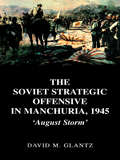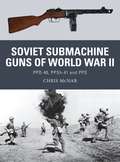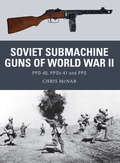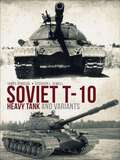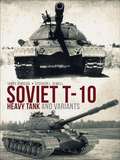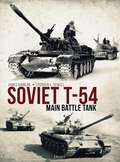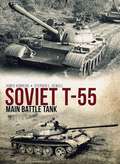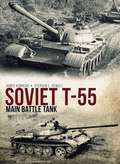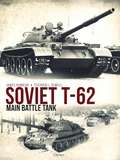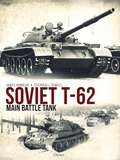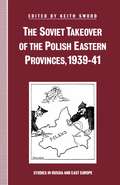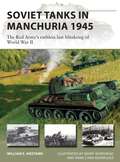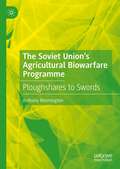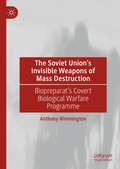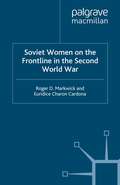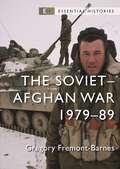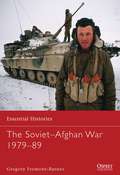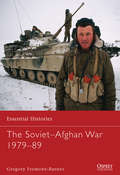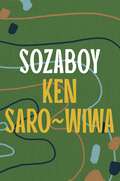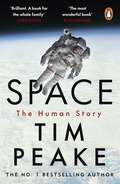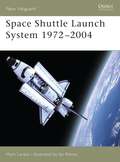- Table View
- List View
The Soviet Strategic Offensive in Manchuria, 1945: 'August Storm'
by David GlantzThis critical examination of the final Soviet strategic offensive operation during World War II seeks to chip away at two generally inaccurate pictures many Westerners have of the war. Specifically, Westerners seem to think that only geography, climate, and sheer numbers negated German military skill and competency on the eastern front, a view that
Soviet Submachine Guns of World War II: PPD-40, PPSh-41 and PPS (Weapon)
by Steve Noon Chris McNab Alan GillilandThe submachine gun (SMG) came to be the embodiment of the Soviet fighting spirit during World War II. From 1943 the Red Army's preference for close-quarters combat resulted in entire infantry units being equipped with nothing but SMGs. By deploying multiple SMG-armed companies and battalions, the Red Army was able to develop ferocious firepower in urban warfare and position assaults, the soldiers keeping within the SMG's effective range of about 150m to nullify the German skills in armoured and manoeuvre warfare, artillery support and aerial bombardment. Featuring expert analysis and an array of specially commissioned full-colour artwork, this engaging study explains the history, use and development of Soviet wartime SMGs in detail. It gives particular focus to the tactical applications of these weapons in combat, and how they compared to firearms wielded by their German opponents. With numerous first-hand combat accounts, and detailed technical explanations, this book is ideal for both the general reader and the firearms enthusiast.
Soviet Submachine Guns of World War II: PPD-40, PPSh-41 and PPS (Weapon #33)
by Steve Noon Chris McNab Alan GillilandThe submachine gun (SMG) came to be the embodiment of the Soviet fighting spirit during World War II. From 1943 the Red Army's preference for close-quarters combat resulted in entire infantry units being equipped with nothing but SMGs. By deploying multiple SMG-armed companies and battalions, the Red Army was able to develop ferocious firepower in urban warfare and position assaults, the soldiers keeping within the SMG's effective range of about 150m to nullify the German skills in armoured and manoeuvre warfare, artillery support and aerial bombardment. Featuring expert analysis and an array of specially commissioned full-colour artwork, this engaging study explains the history, use and development of Soviet wartime SMGs in detail. It gives particular focus to the tactical applications of these weapons in combat, and how they compared to firearms wielded by their German opponents. With numerous first-hand combat accounts, and detailed technical explanations, this book is ideal for both the general reader and the firearms enthusiast.
Soviet T-10 Heavy Tank and Variants
by James Kinnear Stephen SewellWhen it was introduced into service in 1953, the T-10 represented a return to the “classic” Soviet heavy tank. Although considered a major threat to NATO tank forces, it also represented the end of an era. All gun heavy tanks like the T-10 would eventually be made effectively redundant by later models like the T-62 which had powerful next generation armament and new ammunition types. The tank was gradually withdrawn from service in the 1970s, though the last tanks would only leave Russian service, by decree of the President of the Russian Federation, in 1997. As such the T-10 outlived the Soviet state that had created it.Never exported outside of the Soviet Union and rarely used in combat, the T-10 has remained a mysterious tank, with many of its variants unknown in the West until very recently. This study, written from original Russian and Ukrainian primary source documents that have only recently been made available, uncovers the history of this enigmatic tank using 130 stunning contemporary and modern photographs of the T-10 as well as full colour side-view artwork.
Soviet T-10 Heavy Tank and Variants
by James Kinnear Stephen SewellWhen it was introduced into service in 1953, the T-10 represented a return to the “classic” Soviet heavy tank. Although considered a major threat to NATO tank forces, it also represented the end of an era. All gun heavy tanks like the T-10 would eventually be made effectively redundant by later models like the T-62 which had powerful next generation armament and new ammunition types. The tank was gradually withdrawn from service in the 1970s, though the last tanks would only leave Russian service, by decree of the President of the Russian Federation, in 1997. As such the T-10 outlived the Soviet state that had created it.Never exported outside of the Soviet Union and rarely used in combat, the T-10 has remained a mysterious tank, with many of its variants unknown in the West until very recently. This study, written from original Russian and Ukrainian primary source documents that have only recently been made available, uncovers the history of this enigmatic tank using 130 stunning contemporary and modern photographs of the T-10 as well as full colour side-view artwork.
The Soviet T-54 Main Battle Tank
by James Kinnear Stephen Sewell Andrey AksenovThe menacing silhouette of the T-54 tank prowling down streets of Eastern European capitals or roaring across fields in massive exercises remains one of the most enduring images of Soviet power in the early years of the Cold War. Its sleek and unmistakable shape was a warning to any nation that wanted to stand against the USSR. Yet all of this masked a flawed, outdated design, and when T-54s began to clash with the Western armoured vehicles in proxy wars in Southeast Asia and the Middle East they were found to be on the losing side of many of the battles. Containing 130 stunning contemporary and modern photographs, and written by two experts on Soviet armour, this authoritative book tells the complete story of the T-54, one of the most widely produced tanks of all time, including many previously unheard of variants.
The Soviet T-54 Main Battle Tank
by James Kinnear Stephen Sewell Andrey AksenovThe menacing silhouette of the T-54 tank prowling down streets of Eastern European capitals or roaring across fields in massive exercises remains one of the most enduring images of Soviet power in the early years of the Cold War. Its sleek and unmistakable shape was a warning to any nation that wanted to stand against the USSR. Yet all of this masked a flawed, outdated design, and when T-54s began to clash with the Western armoured vehicles in proxy wars in Southeast Asia and the Middle East they were found to be on the losing side of many of the battles. Containing 130 stunning contemporary and modern photographs, and written by two experts on Soviet armour, this authoritative book tells the complete story of the T-54, one of the most widely produced tanks of all time, including many previously unheard of variants.
Soviet T-55 Main Battle Tank
by James Kinnear Stephen SewellThe T-55 is one of the most iconic weapons created by the Soviets during the Cold War and also one of the most widely deployed weapons in history. Like its younger brother, the T-54, the T-55 enjoyed a long career in the Red Army and even into the early days of the reformed Russian Army. Under their control it saw very little combat use or deployments, but it was widely sold to other nations and participated in many of the wars and combat operations from the mid-1960s to the present. The T-55 has been employed in almost every conflict in the Middle East and Africa from its introduction into service. Even today the tank is still employed by both sides in the Syrian Civil War, and they are also in service with Kurdish forces in the struggle against ISIS in the northern part of Iraq.Containing more than 400 stunning contemporary and modern photographs, and written by two experts on Soviet armour, this authoritative book tells the complete story of the T-55, one of the most widely produced tanks of all time.
Soviet T-55 Main Battle Tank
by James Kinnear Stephen SewellThe T-55 is one of the most iconic weapons created by the Soviets during the Cold War and also one of the most widely deployed weapons in history. Like its younger brother, the T-54, the T-55 enjoyed a long career in the Red Army and even into the early days of the reformed Russian Army. Under their control it saw very little combat use or deployments, but it was widely sold to other nations and participated in many of the wars and combat operations from the mid-1960s to the present. The T-55 has been employed in almost every conflict in the Middle East and Africa from its introduction into service. Even today the tank is still employed by both sides in the Syrian Civil War, and they are also in service with Kurdish forces in the struggle against ISIS in the northern part of Iraq. Containing more than 400 stunning contemporary and modern photographs, and written by two experts on Soviet armour, this authoritative book tells the complete story of the T-55, one of the most widely produced tanks of all time.
Soviet T-62 Main Battle Tank
by James Kinnear Stephen SewellThe T-62 is one of the most widespread tanks used by the Soviets during the Cold War. Developed from the T-55, the T-62 enjoyed a long career in the Red Army and even into the early days of the reformed Russian Army. It was the principal tank used by Soviet forces in the Soviet-Afghan War, and went on to see service with Russian forces in Chechnya and South Ossetia. It has also been employed in almost every conflict in the Middle East and Africa from its introduction into service. It remains in service with many countries throughout the world and has seen a great deal of use in the Syrian Civil War. Containing more than 400 stunning contemporary and modern photographs, and written by two experts on Soviet armour, this authoritative book tells the complete story of the T-62.
Soviet T-62 Main Battle Tank
by James Kinnear Stephen SewellThe T-62 is one of the most widespread tanks used by the Soviets during the Cold War. Developed from the T-55, the T-62 enjoyed a long career in the Red Army and even into the early days of the reformed Russian Army. It was the principal tank used by Soviet forces in the Soviet-Afghan War, and went on to see service with Russian forces in Chechnya and South Ossetia. It has also been employed in almost every conflict in the Middle East and Africa from its introduction into service. It remains in service with many countries throughout the world and has seen a great deal of use in the Syrian Civil War. Containing more than 400 stunning contemporary and modern photographs, and written by two experts on Soviet armour, this authoritative book tells the complete story of the T-62.
The Soviet Takeover of the Polish Eastern Provinces, 1939–41 (Studies In Russia And East Europe Ser.)
by Keith SwordSoviet Tanks in Manchuria 1945: The Red Army's ruthless last blitzkrieg of World War II (New Vanguard)
by William E. HiestandA new illustrated study of the devastating, but little-known, Soviet armored blitzkrieg against the Japanese in the last weeks of World War II, and how it influenced Soviet tank doctrine as the Cold War dawned.Although long overshadowed in the West by the dropping of the atomic bombs on Hiroshima and Nagasaki, the USSR's lightning strike into Manchuria in August 1945 was one of the most successful and unique campaigns of the era. Soviet forces, led by over 5,500 tanks and self-propelled guns, attacked across huge distances and deserts, marshes, and mountains to smash Japan's million-strong Kwantung Army in a matter of days.Japanese forces were short of training and equipment, but nevertheless fought fiercely, inflicting 32,000 casualties on the Soviets. Red Army operations were characterized by surprise, speed, and deep penetrations by tank-heavy forces born of the brutal lessons they had learned during years fighting the Wehrmacht. Lessons from the campaign directly shaped Soviet Cold War force structure and planning for mechanized operations against the West.Illustrated with contemporary artwork and rare photos from one of the best collections of Soviet military photos in the West, this fascinating book explains exactly how the last blitzkrieg of World War II was planned, fought, and won, and how it influenced the Red Army's plans for tank warfare against NATO in Europe.
Soviet Tanks in Manchuria 1945: The Red Army's ruthless last blitzkrieg of World War II (New Vanguard #316)
by William E. HiestandA new illustrated study of the devastating, but little-known, Soviet armored blitzkrieg against the Japanese in the last weeks of World War II, and how it influenced Soviet tank doctrine as the Cold War dawned.Although long overshadowed in the West by the dropping of the atomic bombs on Hiroshima and Nagasaki, the USSR's lightning strike into Manchuria in August 1945 was one of the most successful and unique campaigns of the era. Soviet forces, led by over 5,500 tanks and self-propelled guns, attacked across huge distances and deserts, marshes, and mountains to smash Japan's million-strong Kwantung Army in a matter of days.Japanese forces were short of training and equipment, but nevertheless fought fiercely, inflicting 32,000 casualties on the Soviets. Red Army operations were characterized by surprise, speed, and deep penetrations by tank-heavy forces born of the brutal lessons they had learned during years fighting the Wehrmacht. Lessons from the campaign directly shaped Soviet Cold War force structure and planning for mechanized operations against the West.Illustrated with contemporary artwork and rare photos from one of the best collections of Soviet military photos in the West, this fascinating book explains exactly how the last blitzkrieg of World War II was planned, fought, and won, and how it influenced the Red Army's plans for tank warfare against NATO in Europe.
The Soviet Union’s Agricultural Biowarfare Programme: Ploughshares to Swords
by Anthony RimmingtonThis book focuses upon the secret agricultural biological warfare programme codenamed Ekologiya – which was pursued by the Soviet Union from 1958 through to the collapse of the USSR in 1991. It was the largest offensive agricultural biowarfare project the world has ever seen and Soviet anti-crop and anti-livestock weapons had the capability to inflict enormous damage on Western agriculture. Beginning in the early 1970s, there was a new focus within the Soviet agricultural biowarfare programme on molecular biology and the development of genetically modified agents. A key characteristic of the Ekologiya project was the creation of mobilization production facilities. These ostensibly civil manufacturing plants incorporated capacity for production of biowarfare agents in wartime emergency. During the 1990s-2000s, the counter-proliferation efforts undertaken by the US and UK played a major role in preventing the transfer of Ekologiya scientists, technologies and pathogens to Iran and other countries of potential proliferation concern.Anthony Rimmington is a former Senior Research Fellow at Birmingham University’s Centre for Russian, European and Eurasian Studies, UK. He has published widely on the civil life sciences sector in the post-Soviet states and on the Soviet Union’s offensive biological warfare programme, including Stalin’s Secret Weapon: The Origins of Soviet Biological Warfare.
The Soviet Union’s Invisible Weapons of Mass Destruction: Biopreparat's Covert Biological Warfare Programme
by Anthony RimmingtonThis book focuses on Biopreparat, the Soviet agency created in 1974, which spearheaded the largest and most sophisticated biological warfare programme the world has ever seen. At its height, Biopreparat employed more than 30,000 personnel and incorporated an enormous network embracing military-focused research institutes, design centres, biowarfare pilot facilities and dual-use production plants. The secret network pursued major offensive R&D programmes, which sought to use genetic engineering techniques to create microbial strains resistant to antibiotics and with wholly new and unexpected pathogenic properties. During the mid-1980s, Biopreparat increased in size and political importance and also emerged as a major civil biopharmaceutical player in the USSR. In the wake of the collapse of the Soviet Union in 1991, an acute struggle for control of Biopreparat’s most valuable assets took place and the network was eventually broken-up and control of its facilities transferred to a myriad of state agencies and private companies.
Soviet Women on the Frontline in the Second World War
by R. Markwick E. Charon Cardona Euridice Charon CardonaThis is the first comprehensive study in English of Soviet women who fought against the genocidal, misogynist, Nazi enemy on the Eastern Front during the Second World War. Drawing on a vast array of original archival, memoir, and published sources, this book captures the everyday experiences of Soviet women fighting, living and dying on the front.
The Soviet–Afghan War: 1979–89 (Essential Histories)
by Gregory Fremont-BarnesA fully illustrated overview of the USSR's bloody conflict in Afghanistan and its long legacy.The Soviet invasion of its neighbour Afghanistan in December 1979 sparked a nine-year conflict until Soviet forces withdrew in 1988–89, dooming the communist Afghanistan government to defeat at the hands of the mujahideen, the Afghan popular resistance backed by the USA and other powers. Gregory Fremont-Barnes reveals how the Soviet invasion had enormous implications on the global stage; it prompted the US Senate to refuse to ratify the hard-won SALT II arms-limitation treaty, and the USA and 64 other countries boycotted the 1980 Moscow Summer Olympics. For Afghanistan, the invasion served to prolong the interminable civil war that pitted central government against the regions and faction against faction. Updated and revised for the new edition, with full-colour maps and new images throughout, this succinct account explains the origins, events and consequences of the Soviet intervention in Afghanistan, shedding new light on the more recent history – and prospects – of that troubled country.
The Soviet–Afghan War: 1979–89 (Essential Histories)
by Gregory Fremont-BarnesA fully illustrated overview of the USSR's bloody conflict in Afghanistan and its long legacy.The Soviet invasion of its neighbour Afghanistan in December 1979 sparked a nine-year conflict until Soviet forces withdrew in 1988–89, dooming the communist Afghanistan government to defeat at the hands of the mujahideen, the Afghan popular resistance backed by the USA and other powers. Gregory Fremont-Barnes reveals how the Soviet invasion had enormous implications on the global stage; it prompted the US Senate to refuse to ratify the hard-won SALT II arms-limitation treaty, and the USA and 64 other countries boycotted the 1980 Moscow Summer Olympics. For Afghanistan, the invasion served to prolong the interminable civil war that pitted central government against the regions and faction against faction. Updated and revised for the new edition, with full-colour maps and new images throughout, this succinct account explains the origins, events and consequences of the Soviet intervention in Afghanistan, shedding new light on the more recent history – and prospects – of that troubled country.
The Soviet–Afghan War 1979–89 (Guide to...)
by Gregory Fremont-BarnesThe Soviet invasion of its neighbour Afghanistan in December 1979 sparked a bloody nine-year conflict in that country until Soviet forces withdrew in 1988–89, dooming the communist Afghanistan government to defeat at the hands of the Mujahideen, the Afghan popular resistance backed by the USA and other powers. The Soviet invasion had enormous implications on the global stage; it prompted the US Senate to refuse to ratify the hard-won SALT II arms-limitation treaty, and the USA and 64 other countries boycotted the 1980 Moscow Summer Olympics. For Afghanistan, the invasion served to prolong the interminable civil war that pitted central government against the regions and faction against faction. The country remains locked in conflict over 30 years later, with no end in sight. Featuring specially drawn mapping and drawing upon a wide range of sources, this succinct account explains the origins, history and consequences of the Soviet intervention in Afghanistan, thereby shedding new light on the more recent history – and prospects – of that troubled country.
The Soviet–Afghan War 1979–89 (Essential Histories)
by Gregory Fremont-BarnesThe Soviet invasion of its neighbour Afghanistan in December 1979 sparked a bloody nine-year conflict in that country until Soviet forces withdrew in 1988–89, dooming the communist Afghanistan government to defeat at the hands of the Mujahideen, the Afghan popular resistance backed by the USA and other powers. The Soviet invasion had enormous implications on the global stage; it prompted the US Senate to refuse to ratify the hard-won SALT II arms-limitation treaty, and the USA and 64 other countries boycotted the 1980 Moscow Summer Olympics. For Afghanistan, the invasion served to prolong the interminable civil war that pitted central government against the regions and faction against faction. The country remains locked in conflict over 30 years later, with no end in sight. Featuring specially drawn mapping and drawing upon a wide range of sources, this succinct account explains the origins, history and consequences of the Soviet intervention in Afghanistan, thereby shedding new light on the more recent history – and prospects – of that troubled country.
The Soviet–Afghan War 1979–89 (Essential Histories)
by Gregory Fremont-BarnesThe Soviet invasion of its neighbour Afghanistan in December 1979 sparked a bloody nine-year conflict in that country until Soviet forces withdrew in 1988–89, dooming the communist Afghanistan government to defeat at the hands of the Mujahideen, the Afghan popular resistance backed by the USA and other powers. The Soviet invasion had enormous implications on the global stage; it prompted the US Senate to refuse to ratify the hard-won SALT II arms-limitation treaty, and the USA and 64 other countries boycotted the 1980 Moscow Summer Olympics. For Afghanistan, the invasion served to prolong the interminable civil war that pitted central government against the regions and faction against faction. The country remains locked in conflict over 30 years later, with no end in sight. Featuring specially drawn mapping and drawing upon a wide range of sources, this succinct account explains the origins, history and consequences of the Soviet intervention in Afghanistan, thereby shedding new light on the more recent history – and prospects – of that troubled country.
Sozaboy
by Ken Saro-WiwaSozaboy powerfully describes the fate of a young, naive soldier thrown into the frontline of a civil war, from his first proud days of recruitment to the disillusionment and horrors that follow.Mene yearns for manhood. He dreams of gaining the glory that the ex-soldier in his village brags about, with his stories of hunting 'Hitla'. So when war breaks out and soldiers appear in Mene's isolated village, he sees his chance to finally wear a uniform. Too soon, however, Mene's innocence turns to terror. While witnessing the unfathomable, Mene must learn to evade the carnage of warfare if he wants to make it home alive...Writing in Nigerian Pidgin English, Ken Saro-Wiwa creates a unique window into the dark consequences of meaningless war.'Haunting.' Guardian 'Sozaboy is not simply a great African novel, it is also a great anti-war novel, among the very best the twentieth century has produced.' William Boyd
Space: A thrilling human history by Britain's beloved astronaut Tim Peake
by Tim PeakeFrom bestselling author and British astronaut Tim Peake, an inspirational human history of space travel, from the Apollo missions to our future forays to Mars. The Right Stuff for a new generation.'This book is brilliant - once in a blue moon. A book for the whole family.' Chris Evans, Virgin Radio'The most wonderful book ... Tim Peake is a historian and encyclopaedia of space.’ Rory Stewart'An extraordinary book. For anyone - even if you’re not interested in Space. If you’re interested in human stories and the human character - this is delightful.' BBC Breakfast'A fascinating, detailed, playful book drawn from extensive research – Peake met seven Apollo astronauts, Russian cosmonauts and various other space technicians – as well as his considerable personal experience. Lifts the lid on what space is like: the dedication and sacrifice; the politics and pantomime; the practicalities and the peril; the glory and fame; the adjustment back to normal life.' iPaper'A thrilling human history of space' Daily Mirror'The bible of space travel' Chris Moyles, Radio XAs seen in the major TV series Secrets of Our Universe with Tim Peake.Only 656 people in human history have left Earth. In Space: The Human Story, astronaut Tim Peake traces the lives of these remarkable men and women who have forged the way, from Yuri Gagarin to Neil Armstrong, from Valentina Tereshkova to Peggy Whitson.Full of exclusive new stories, and astonishing detail only an astronaut would know, the book conveys what space exploration is really like: the wondrous view of Earth, the surreal weightlessness, the extraordinary danger, the surprising humdrum, the unexpected humour, the newfound perspective, the years of training, the psychological pressures, the gruelling physical toll, the thrill of launch and the trepidation of re-entry. The book also examines the surprising, shocking and often poignant stories of astronauts back on Earth, whose lives are forever changed as they readjust to terra firma.Publication of the book comes on the eve of NASA's plans to return to the moon, fifty years after an astronaut last walked on the lunar surface. In 2024 the Artemis II mission will send four astronauts to orbit the moon. In 2025 Artemis III will send the first woman and the first person of colour to step on the lunar surface. What will separate these upcoming moonwalkers from the legendary Apollo crews? Does it still take a daring-do attitude, super-human fitness, intelligence, plus the 'Right-stuff' - a fabled grace under pressure? And how will astronauts travel even further - to Mars and beyond? Space: The Human Story reveals all.
Space Shuttle Launch System 1972–2004 (New Vanguard)
by Ian Palmer Mark LardasThe Space Shuttle is one of the oldest and most famous manned launch systems – the only launch vehicle that has been used for a longer period of time is the Soviet (now Russian) R-7 booster. By the start of the third millennium, the Space Shuttle had carried crews into space over 85 times. Although not a military structure, the Shuttle had been sold as an all-purpose launch system to be used jointly for military and civilian purposes. Featuring full-colour photos throughout, this book covers the design, development and operational history of a unique vehicle.
